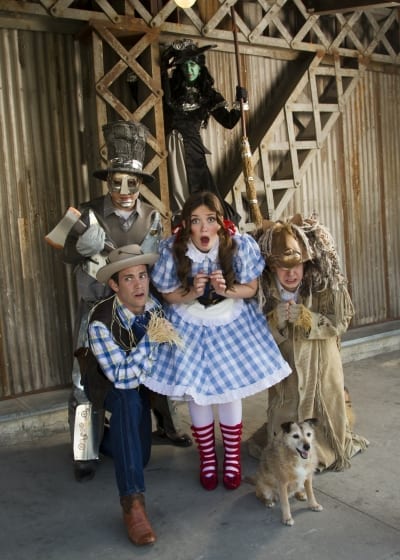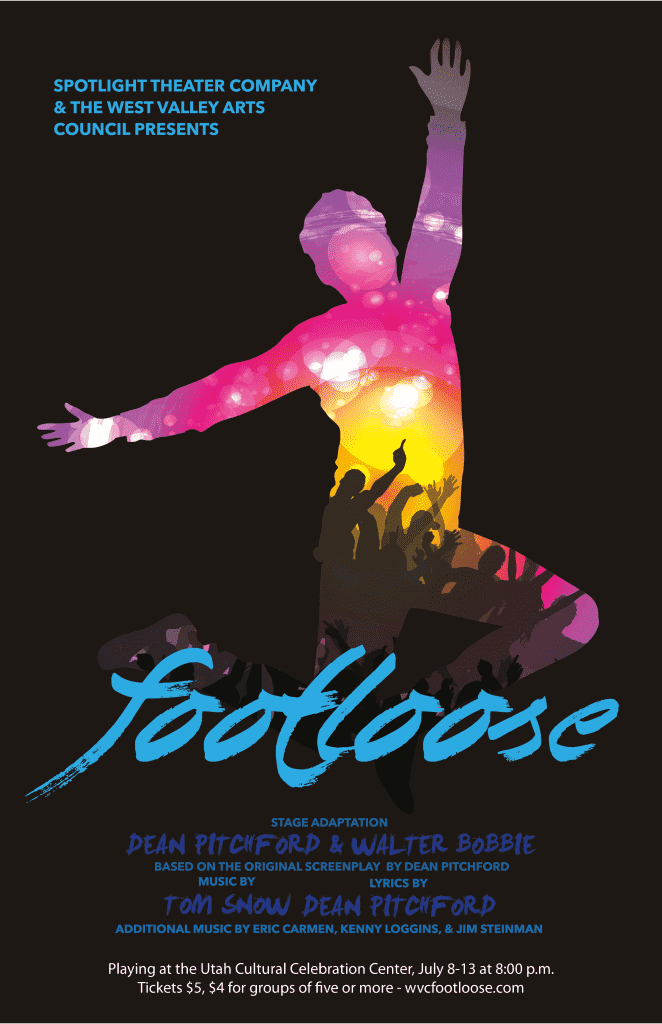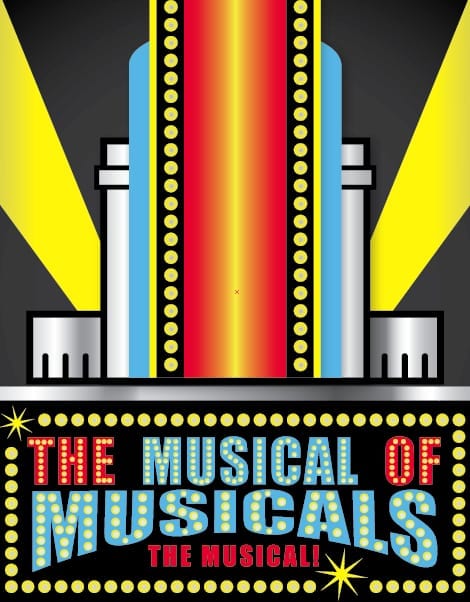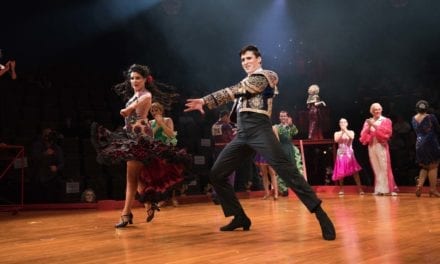OREM — When I went on Friday to see . . . Wait, what’s that Sweetheart? Friday is our 10-year anniversary? Oh, . . . ok.
When I went on Saturday to see . . . wait, what’s that? There are 45 MPH gusting winds and the show is outside? Oh . . . ok.
When I went on Monday (Are we safe? No surprises? WHEW!) to see SCERA’s production of The Wizard of Oz—a piece of American history—I was very excited! After all, my anticipation had been building for a number of days!
If you’ve not seen a production at the outdoor SCERA Shell amphitheater in Orem, I would highly recommend it. It’s a great location which is, this year, celebrating its 28th season. There is certainly a strong vibe of community in the outdoor amphitheater. Families lining up their blankets and folding chairs, huddling together to gain the best vantage point, chattering excitedly about the impending show.
The stage is set with a few small set pieces, establishing that the story begins on the Gale farm: a fence, a front porch, storm cellar doors—the basics. I may be particularly sensitive, but the lead in music seemed an odd and distracting choice. Classical sounding covers of 10-year-old pop songs were being piped, rather loudly, over the crowd leading up to the show. I just felt it was a rather missed opportunity to set the tone for the performance and bring the audience back to the time and place where the show would take place.
As the show started, the stage flooded with dozens of fresh-faced children, skipping rope, playing hopscotch and tag. Among them was 16-year-old Jessica Sundwall, portraying Dorothy. She is adorable in the expected blue and white checkered dress, pigtails and all. As soon as she begins singing “Somewhere Over the Rainbow,” it’s clear why she was cast. She has a magnetic voice. Throughout the play, her performance was serviceable, and at times was great (particularly when taken captive by a certain green fiend). It seemed that a few minor directorial cues would have served her well to round out the edges of her portrayal. She could have worked a bit on staying in the moment (particularly when she’s involved in the scene, but not speaking). But for such a young performer I was impressed.
Next the audience was introduced to Aunt Em and Uncle Henry. The age difference between the performers was very pronounced and it didn’t seem that any efforts were made to bridge that gap. Rob Holcombe seemed a near-perfect fit for Uncle Henry and pulled the part off quite well, lending a steady hand and some great comedic timing to the opening scenes. Emily Hill’s take on Aunt Em, meanwhile, was very off-putting to me. I felt that she was far too gruff and frustrated, and sometimes eclipsed even Almira Gulch’s callousness. The maternal, supportive, reserved element was certainly lacking in my opinion.
As to Almira Gulch, played by Shoni Winkel (who also tackled the responsibility of playing the Wicked Witch), I find myself at an impasse. I understand the profound effect that the musical Wicked has had on many young female performers. (How could it not?) However, I personally feel that if you’re going to change something that is truly iconic, you need to make it better, not just different. Winkle chose the direction of drastic modernization in her portrayal of both Gultch and The Wicked Witch. In the delivery of many of her lines and the overall demeanor, Winkle shied away from the menacing aspects of her characters. For me, the choice did not play well in the context of the rest of the play because it sometimes seemed to rob Dorothy’s situation of peril. On the other hand, Winkle was very devoted to the production and her performance was a bright point of the show, even if it wasn’t as scary as I had hoped.
Winkle’s choices, and many others in this production, may have been her direction from Jeremy Showgren’s vision, which was to modernize The Wizard of Oz, but the vision often didn’t work for me. This modernization, which included inserting little jokes in the stage business and visual designs, was something done by many of the performers throughout the show. To me, these attempts did not serve to enhance the text, and as such felt hackneyed and a little desperate. (Although I admit that I noted and appreciated the crows’ callout to the TV Series Arrested Development.) However, there were some audience members around me who seemed to appreciate these directorial choices much more than I did, so this might just be an issue of mine. But for me, ruby slippers—for example—should be just that: slippers, not shin-high boots.
 The scenic design, done by Casey Price, worked quite well. The handling of the tornado and Dorothy’s trip to Oz was done in an inventive and interesting way. Once in Oz the audience met Glinda, played quite well by Lauren Anderson, whose vapid self-obsession came across nicely. Dorothy was also surrounded by Munchkins, who were nearly exclusively small children. I found myself wishing that something had been done in costuming, or even physicality direction, to make a distinction between this simply being a group of children versus a distinct race of Munchkins. That aside, they were adorable and very focused on the production, which was, of course, heart-warming.
The scenic design, done by Casey Price, worked quite well. The handling of the tornado and Dorothy’s trip to Oz was done in an inventive and interesting way. Once in Oz the audience met Glinda, played quite well by Lauren Anderson, whose vapid self-obsession came across nicely. Dorothy was also surrounded by Munchkins, who were nearly exclusively small children. I found myself wishing that something had been done in costuming, or even physicality direction, to make a distinction between this simply being a group of children versus a distinct race of Munchkins. That aside, they were adorable and very focused on the production, which was, of course, heart-warming.
Off heads Dorothy down the Yellow Brick Road to meet the Scarecrow (Mark Gordon), the Tinman (Travis Hancock) and the Lion (Phillip Varney). Sadly, each seemed distant and disconnected in their own way. There were certainly things to appreciate in each of their performances, and I feel a few minor directional changes could have made a world of difference. For example, Gordon seemed to be constantly mugging to the audience to punctuate jokes or physical antics, almost jabbing us with his elbow, nearly begging for laughs or approval. Hancock was generally very difficult for me to understand. I found myself straining to pickup his words; simply reminding him to enunciate and project could have served us well. As for Varney, I was bothered by his meandering and inconsistent accent and vocal choices during the show.
I must also address the costumes, designed by Kelsey Seaver. My chief complaint in the costumes had to be the Lion’s mask. It was a fixed, huge, mane-covered helmet, which completely obstructed Varney’s face. I could see his chin and nothing more. That made it very difficult to connect with him and I found myself feeling very bad for him—and for the audience for missing his performance almost entirely. Small changes, such as adding silver gloves to the Tinman’s outfit, a bit of makeup to the scarecrows eyes or nose, showing the Lion’s face, would really have enhanced my connection to those characters. I don’t mean to nitpick; I just believe these minor things may have made a massive difference in the way I felt about these characters—and I want actors to have every chance possible to succeed.
The choregraphy, done by Kellie Messerly, worked nicely throughout and was especially enjoyable during the Jitterbug number. The performers were challenged, but not beyond their abilities, and the dancing was a high point of the evening for me. The general company kept themselves busy and involved in the scenes without being distracting. I applaud their efforts.
All told, I had a nice time at this production. Taking on a piece that’s so engrained in the psyche of America is like so many “American Idol” hopefuls attempting to best Aretha Franklin on “Natural Woman.” You’re not going to do it better, and you can’t stray too far away from the original, but you HAVE to make it your own somehow. It’s like riding unicycle across a tightrope, blindfolded while balancing an aquarium on your nose . . . with just 12 hours practice! This is a different Wizard of Oz—one that seems familiar but also at times strange. Not everything in this show worked, in my opinion. However, most of the cast seemed very committed and, as the show ended, I was pleased to have been there.







